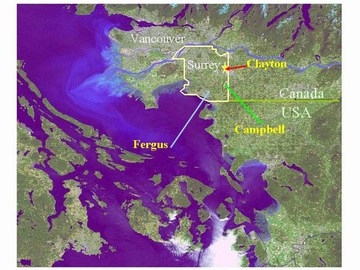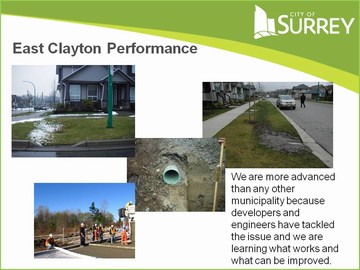City of Surrey case study experience is genesis for Stream Health Methodology embedded in Water Balance Model
Note to Readers:
Day 1 of the From Rain to Resource Workshop on October 28 in Kelowna is geared toward technical operational and planning staff . The focus is on site-level best practices and tools to deal with various situations. One of the case studies is the East Clayton ‘green’ development in the City of Surrey.

Green Infrastructure Innovation
 “A decade ago, the East Clayton development in Surrey was the first development in the Lower Mainland that utilized green infrastructure techniques and facilities. Looking back, application of the water balance methodology to East Clayton can now be seen as the genesis for the Stream Health Methodology that is embedded in the Water Balance Model powered by QUALHYMO,” reports Kim Stephens, Executive Director of the Partnership for Water Sustainability in British Columbia.
“A decade ago, the East Clayton development in Surrey was the first development in the Lower Mainland that utilized green infrastructure techniques and facilities. Looking back, application of the water balance methodology to East Clayton can now be seen as the genesis for the Stream Health Methodology that is embedded in the Water Balance Model powered by QUALHYMO,” reports Kim Stephens, Executive Director of the Partnership for Water Sustainability in British Columbia.
Application of Performance Targets
“With hindsight, the significance of East Clayton is two-fold. It was an early application of performance targets at a neighbourhood scale. Also, and most importantly the analysis combined mass balance and flow duration to test the achievability of performance targets,” states Jim Dumont, Engineering Applications Authority for the Inter-Governmental Partnership that is responsible for the Water Balance Model.
 “But it was the South Newton case study where the methodology really came together in terms of how to integrate the mass balance and stream erosion analyses. Until then, they were separate analyses.”
“But it was the South Newton case study where the methodology really came together in terms of how to integrate the mass balance and stream erosion analyses. Until then, they were separate analyses.”
“In South Newton, we were able to demonstrate that distributed rainwater infiltration systems could result in a multi-million dollar net reduction in the City’s 10-Year Capital Plan, while enabling development to proceed. The saving results from elimination of a number of detention ponds.”
“The experience gained in East Clayton and South Newton was then applied in Fergus Creek. The Beyond the Guidebook methodology was formalized as the Stream Health Methodology, and subsequently incorporated in the Water Balance Model when it was integrated with the QUALHYMO engine. The Stream Health Methodology is a function of flow duration, and hence stream erosion,” concludes Jim Dumont.
To Learn More:
Click on Application of the “DFO Urban Stormwater Guidelines” has evolved over the past decade to protect stream health — This story provides context for the 4-page ‘Urban Stormwater Guidelines and Best Management Practices for Protection of Fish and Fish Habitat’ – how they set a direction in 2001; how they have evolved into ‘Beyond the Guidebook’; and how the Water Balance Model is a tool to correlate runoff volume management with stream erosion and water quality outcomes.
Click on Beyond the Guidebook 2010 Advances Runoff-Based Approach to Setting Watershed Performance Targets — “A framework for developing integrated and holistic plans is consolidated in a single table. This ‘mind-map’ lays out the cascading logic for establishing, evaluating and implementing watershed-specific runoff targets that will protect stream health.”
Click on A crucially important message in Beyond the Guidebook 2010: “We now have the tools and experience to design with nature” — “So many in local government are searching for the magical ‘silver bullet’to resolve watershed issues and challenges. Yet soil, vegetation and trees can do more for our watersheds than decades of planning, consulting and complicated engineering design will ever achieve.”
Click on Water Balance Model can create an understanding of the past and compare it to many possible futures — “A key message is that the Water Balance Model is a ‘scenario comparison tool’. This is where the WBM shines as it is not constrained by starting or ending points. It compares whatever the user can envision.”


